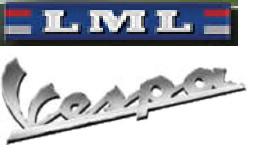The first time I saw the first branch of Yellow Cab Pizza in Makati Ave. back in 2001, my wife & I agreed that we have got to try the place. It just had that interesting appeal. When we went in, I’ve instantly assumed that it was a local franchise of a New York-based pizza place. The ‘feel’ of the store is just not local. The unpainted concrete façade, the b&w New York photographs, the big box & big slices and those ‘cute’ yellow delivery scoots. Bearing a name with the word ‘cab’ in a country that calls it a ‘taxi’ also doesn’t help.
It was only recently, while having a chat with our friends from Yabang Pinoy, when I learned that Yellow Cab Pizza is a 100% Filipino-owned company. The assumptions I had about the store is a product of a good market positioning and a great understanding of the Filipino psyche. I hate being swayed by any marketing gimmicks but their’s just hit me where I least expected it (subconscious) and I didn’t know that I already fell for it the moment I decided to my first visit. I have to say, it’s just pure marketing genius!
Delivery with pizzazz
The following is a business success story in which motor vehicles, two-wheeled as well as four-wheeled, played-and continue to play-a starring role.
It is about a pizza parlor that was established in 2001 by Mr. E.P., a Filipino entrepreneur. Today, Yellow Cab Pizza has 54 stores across the country, as far north in Baguio City and as far south as Davao. Not bad for an all-Filipino enterprise that was opened only five years ago in competition with famous, well-established global brands such as Shakey’s, Pizza Hut and Wendy’s.
Different
What makes Yellow Cab Pizza different from other pizza chains, both local and international, is the pizzazz of its delivery system. When you order pizza from Yellow Cab, it is delivered to you via a 150 cc Vespa, the prestigious Italian motor scooter. Other pizza brands use less glamorous transportation, usually Japanese motorcycles such as the Kawasaki 100 cc.
Yellow Cab has 400 Vespas-all painted yellow, of course-across the country to deliver its products on time. Aside from 400 Vespas, Yellow Cab has a 2002 model Chrysler PT Cruiser, painted in the same bright yellow color, that is used for special occasions such as at the grand opening of a store, motorcades, car shows and sponsorship events.
Image builder
Mr. E.P. acquired the PT Cruiser for P1.5 million in 2004 from Kevin Limjoco, C! Magazine’s editor-at-large. “The PT Cruiser is meant to build the image of Yellow Cab,” Mr E.P. said in an interview. “The character of the car is what I wanted to portray-young, hip, retro, very much like the Vespa design.” It helps that the PT Cruiser is not sold in the Philippines and is rarely seen on Philippine roads, thus contributing to the eye-catching mystique of the Yellow Cab brand. Only young people-students and models-get to drive the PT Cruiser, Mr. E.P. revealed. He himself does not drive it.
It is actually logical for Yellow Cab Pizza to own and parade a yellow automobile from America, since the pizza business was named after the ubiquitous yellow taxicabs in New York City. But while the cabs in New York are big, full-size, 6 or 8-cylinder passenger sedans, the PT Cruiser is a compact hatchback with a 2.4-liter, 4-cylinder twin cam engine producing 150 peak horsepower.Boost sales
Together with the Chrysler 300 C executive sedan, the PT Cruiser is credited with boosting sales of the Chrysler division of DaimlerChrysler in the first five years of the 2000s. The PT Cruiser has been consistently recommended by Consumer Reports for four years now mainly because of its reliability and versatile interior. The rear seats can be removed and the front passenger seat folded flat to increase cargo space.
With 400 Vespas at hand, Yellow Cab may well be the company with the largest number of Vespas in the world. Ninety percent of the Vespa fleet was purchased brand-new with the remaining 10 percent acquired secondhand. Mr. E.P. said that the average price of a new Vespa is P80,000 (compared to the P60,000 retail price of a 100 cc Kawasaki) while a used Vespa costs around P50,000. Mr. E.P. sources the Vespas from Italy, where the original Piaggio Vespa is manufactured and from India, where the scooter is produced by LML. There is a Vespa distributor in Metro Manila that sells both. Seventy percent of the Yellow Cab fleet are Piaggio Vespas and the rest, LML Vespas.
Mr. E.P. says that the Vespa has been a part of his life since he was a child. His father rode a Vespa in the 1950s and 1960s and when the Vespa returned to Manila in the 1990s, Mr. E.P. bought one and rode it to work in Makati almost daily. At one time, he even rode his Vespa all the way to Pagudpud, Ilocos Norte.
Rolling stock
When he was organizing Yellow Cab Pizza, Mr. E.P. saw that the Vespa has a lot of paintable surfaces for advertisements. Perhaps this is one reason he chose the Vespa for Yellow Cab’s rolling stock. Another reason could be the Vespa’s durability. Mr. E.P. says that the Vespa is less prone to break down since the spindle coming from the transmission is attached to the wheel and motion is not transferred by a chain.
In any case, choosing the Vespa and the PT Cruiser to distinguish the Yellow Cab brand was a stroke of marketing genius. Now the question is: When will CATS Motors Inc., the Philippine distributor of Chrysler, Dodge and Jeep, make the PT Cruiser available here?

No comments:
Post a Comment